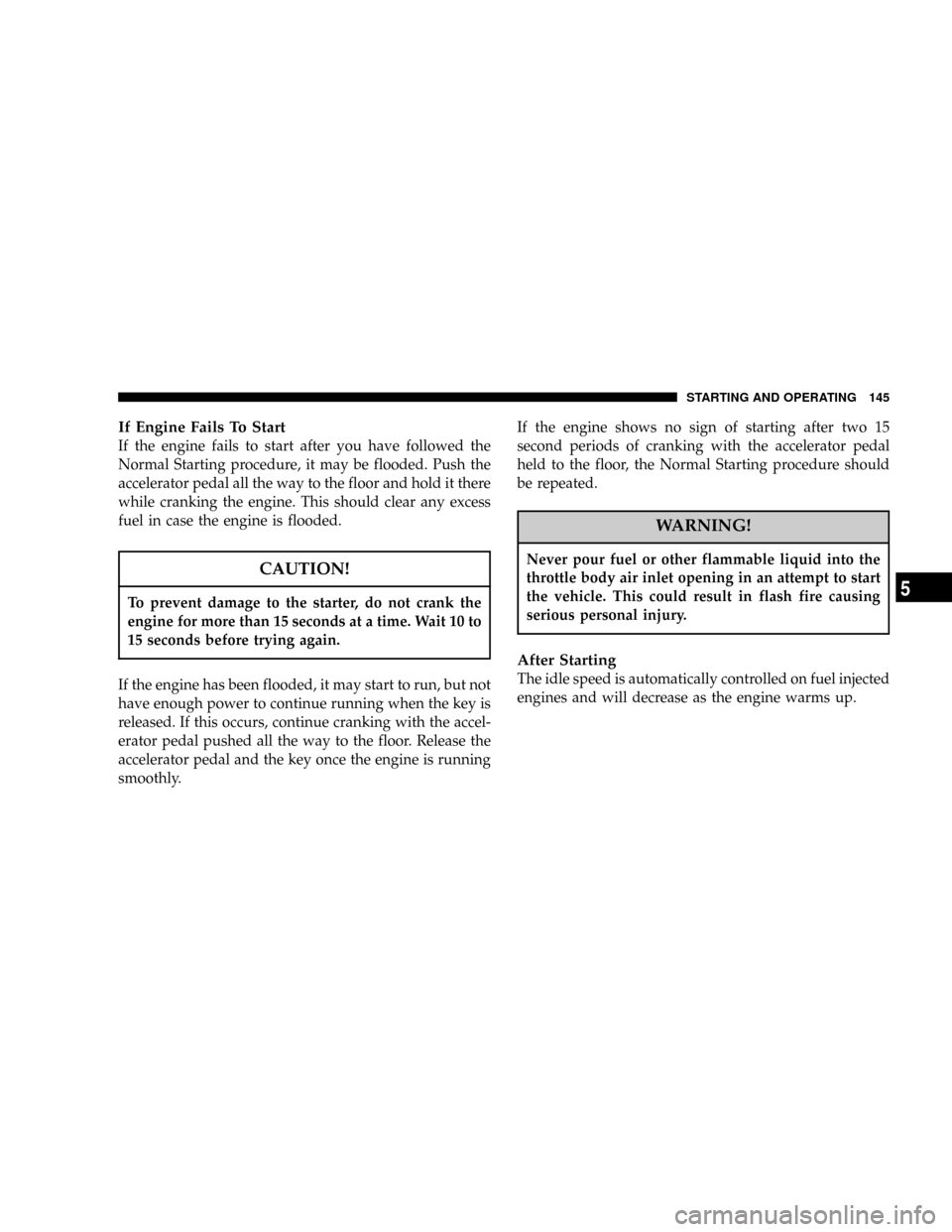2004 DODGE DAKOTA fuel
[x] Cancel search: fuelPage 135 of 300

Air Conditioning Operation
To turn on the Air Conditioning, set the fan control at any
speed and press the snowflake button located at the right
of the control panel. Conditioned air will be directed
through the outlets selected by the mode control. A light
in the snowflake button shows that the air conditioning is
on. Press the button a second time to turn the air
conditioning off.
Slight changes in engine speed or power may be noticed
when the air conditioning compressor is on. This is anormal occurrence as the compressor will cycle on and
off to maintain comfort and increase fuel economy.
The mode control (at the right of the
control panel) can be set in any of the
following positions:
NOTE:To improve your selection choices, the system
allows you to operate at intermediate positions between
the major modes. These intermediate positions are iden-
tified by the small dots.
Recirculation Modes (Panel or Bi-Level )
Select the recirculation modes when
the outside air contains smoke, odors,
high humidity, or if rapid cooling is
desired. This feature allows for recir-
culation of interior air only. Air flows
through the panel outlets in this mode.
INSTRUMENT PANEL AND CONTROLS 135
4
Page 142 of 300

NTire Markings........................167
NTire Identification Number (TIN)..........171
NTire Loading And Tire Pressure...........172
mTiresÐGeneral Information...............175
NTire Pressure.........................175
NTire Inflation Pressures.................176
NRadial-Ply Tires......................178
NCompact Spare Tire Ð If Equipped.........178
NTire Spinning........................179
NTread Wear Indicators..................180
NReplacement Tires.....................180
NAlignment And Balance.................181
mSupplemental Tire Pressure Information.....182
mTire Chains...........................182
mSnow Tires...........................183
mTire Rotation Recommendations...........183
mFuel Requirements.....................184
NReformulated Gasoline.................184
NGasoline/Oxygenate Blends..............185
NMMT In Gasoline.....................185
NSulfur In Gasoline.....................185
NMaterials Added To Fuel................186
mAdding Fuel..........................186
NFuel Filler Cap (Gas Cap)...............186
NFuel Tank Filler Tube...................187
NFuel System Cautions..................188
NCarbon Monoxide Warnings..............189
mCatalytic Converter.....................189
mVehicle Loading.......................191
NCertification Label.....................191
NCurb Weight.........................192
NLoading............................192
142 STARTING AND OPERATING
Page 144 of 300

STARTING PROCEDURES
The starter should not be operated for more than 15
second intervals. Waiting a few seconds between such
intervals will protect the starter from overheating.
Manual Transmission
Apply the parking brake, place the gearshift control lever
in NEUTRAL and depress clutch pedal to the floor before
starting the vehicle. This vehicle is equipped with a
clutch interlocking ignition system. It will not start unless
the clutch is depressed.
Automatic Transmission
Start the engine with the shift lever in NEUTRAL or
PARK position. Apply the brake before shifting to any
driving range.
WARNING!
Do not attempt to push or tow your vehicle to get it
started. Vehicles equipped with an automatic trans-
mission cannot be started this way. Unburned fuel
could enter the catalytic converter and once the
engine has started, ignite and damage the converter
and vehicle. If the vehicle has a discharged battery,
booster cables may be used to obtain a start from a
booster battery or the battery in another vehicle. This
type of start can be dangerous if done improperly.
See section 6 of this manual for the proper jump
starting procedures and follow them carefully.
Normal Starting
Normal starting of either a warm or cold engine is
obtained without pumping or depressing the accelerator
pedal. Turn the key to the START position and release
when the engine starts. If the engine fails to start within
10 seconds, turn the key to the OFF position, wait 5
seconds, then repeat the starting procedure.
144 STARTING AND OPERATING
Page 145 of 300

If Engine Fails To Start
If the engine fails to start after you have followed the
Normal Starting procedure, it may be flooded. Push the
accelerator pedal all the way to the floor and hold it there
while cranking the engine. This should clear any excess
fuel in case the engine is flooded.
CAUTION!
To prevent damage to the starter, do not crank the
engine for more than 15 seconds at a time. Wait 10 to
15 seconds before trying again.
If the engine has been flooded, it may start to run, but not
have enough power to continue running when the key is
released. If this occurs, continue cranking with the accel-
erator pedal pushed all the way to the floor. Release the
accelerator pedal and the key once the engine is running
smoothly.If the engine shows no sign of starting after two 15
second periods of cranking with the accelerator pedal
held to the floor, the Normal Starting procedure should
be repeated.
WARNING!
Never pour fuel or other flammable liquid into the
throttle body air inlet opening in an attempt to start
the vehicle. This could result in flash fire causing
serious personal injury.
After Starting
The idle speed is automatically controlled on fuel injected
engines and will decrease as the engine warms up.
STARTING AND OPERATING 145
5
Page 149 of 300

The ªO/D OFFº feature must be selected, if desired, each
time the engine is started.
NOTE:If the vehicle is started in extremely cold
temperatures, the transmission may not shift into Over-
drive and will automatically select the most desirable
gear for operation at this temperature. Normal operation
will resume when the transmission fluid temperature has
risen to a suitable level. Refer also to the Note under
torque converter clutch, later in this section.
If the transmission temperature gets extremely hot, the
transmission will automatically select the most desir-
able gear for operation at this temperature. If the
transmission temperature becomes hot enough the
O/D OFF and/or TRANS TEMP light(s) may illumi-
nate and the transmission may downshift out of
Overdrive until the transmission cools down. After
cooldown, the transmission will resume normal op-
eration.
When To Lock Out Overdrive
When driving in hilly areas, towing a trailer, carrying a
heavy load, or whenever frequent transmission shifting
occurs, press the ªO/D OFFº button. This will improve
performance and reduce the potential for transmission
overheating or failure due to excessive shifting.
Torque Converter Clutch
A feature designed to improve fuel economy is included
in all automatic transmissions. A clutch within the torque
converter engages automatically at a calibrated speed at
light throttle. It engages at higher speeds under heavier
acceleration. This may result in a slightly different feeling
or response during normal operation in high gear. When
STARTING AND OPERATING 149
5
Page 151 of 300

To shift into Reverse, come to a complete stop. Depress
the clutch and pause briefly to allow the gear train to spin
down. Move the shift lever from the Neutral position
straight across and back into Reverse.
Never drive with your foot resting on the clutch pedal.
Do not attempt to hold the vehicle on a hill with the
clutch pedal partially engaged, as this will cause abnor-
mal wear on the clutch.
Recommended Shift Speeds
To use your manual transmission for fuel economy it
should be upshifted as listed below. Shift at the vehicle
speeds listed for acceleration and cruise conditions (rela-
tively steady speeds).
Recommended Manual Transmission Shift Speeds in
MPH (KM/H)
Engine Model 1 to 2 2 to 3 3 to 4 4 to 5
3.7L/
4.7LAll 15 (24) 25 (40) 40 (64) 45 (72)
Higher upshift speeds may be used to obtain a desired
acceleration rate.
Downshifting
Moving from a high gear down to the lower gears in
descending numerical order is recommended to preserve
brakes when driving down steep hills. In addition,
downshifting at the right time provides better accelera-
tion when you want to resume speed. For acceleration
initiated at speeds less than 20 mph (30 km/h), second
gear is recommended.
FOUR-WHEEL DRIVE OPERATION
NV 233 Transfer Case Operating
Information/Precautions
The NV233 is an electric shift transfer case and is
operated by the 4WD Control Switch (Transfer Case
Switch), which is located on the instrument panel.
The NV233 transfer case provides 4 mode positions: 2
(rear) wheel drive high range, 4 wheel drive high range,
4 wheel drive low range, and neutral.
The NV233 transfer case is designed to be driven in the 2
wheel drive position (2WD) for normal street and high-
way conditions (dry hard surfaced roads).
STARTING AND OPERATING 151
5
Page 176 of 300

2. EconomyÐ
Improper inflation pressures can cause uneven wear
patterns to develop across the tire tread. These abnormal
wear patterns will reduce tread life resulting in a need for
earlier tire replacement. Underinflation also increases tire
rolling resistance and results in higher fuel consumption.
3. Ride Comfort and Vehicle StabilityÐ
Proper tire inflation contributes to a comfortable ride.
Overinflation produces a jarring and uncomfortable ride.
Tire Inflation Pressures
The proper cold tire inflation pressure for passenger cars
is listed on either the face of the driver's door or the
driver's side ªBº pillar. For vehicles other than passenger
cars, the cold tire inflation pressures are listed on either
the ªBº pillar, the Certification Label or in the Tire
Inflation Pressures brochure in the glove compartment.
Some vehicles may have Supplemental Tire Pressure
Information for vehicle loads that are less that the maxi-
mum loaded vehicle condition. These pressure condi-
tions will be found in the ªSupplemental Tire Pressure
Informationº section of this manual.The pressure should be checked and adjusted as well as
inspecting for signs of tire wear or visible damage at least
once a month. Use a good quality pocket-type gauge to
check tire pressure. Do not make a visual judgement
when determining proper inflation. Radial tires may look
properly inflated even when they are underinflated.
ªBº PILLAR
176 STARTING AND OPERATING
Page 184 of 300

Follow the recommended tire rotation frequency for your
type of driving found in the ªMaintenance Schedulesº
Section of this manual. More frequent rotation is permis-
sible if desired. The reasons for any rapid or unusual
wear should be corrected prior to rotation being per-
formed.
FUEL REQUIREMENTS
Your engine is designed to meet all emissions regulations
and provide excellent fuel economy and performance
when using high quality unleaded ªregularº gasoline
having an octane rating of 87. The routine use of pre-
mium gasoline is not recommended. Under normal con-
ditions the use of premium fuel will not provide a benefit
over high quality regular gasolines and in some circum-
stances may result in poorer performance.
Light spark knock at low engine speeds is
not harmful to your engine. However, con-
tinued heavy spark knock at high speeds
can cause damage and immediate service
is required. Engine damage resulting from
operation with a heavy spark knock may
not be covered by the new vehicle warranty.Poor quality gasoline can cause problems such as hard
starting, stalling and hesitations. If you experience these
symptoms, try another brand of ªregularº gasoline be-
fore considering service for the vehicle.
Over 40 auto manufacturers world-wide have issued and
endorsed consistent gasoline specifications (the World-
wide Fuel Charter, WWFC) to define fuel properties
necessary to deliver enhanced emissions, performance
and durability for your vehicle. The manufacturer recom-
mends the use of gasolines that meet the WWFC speci-
fications if they are available.
Reformulated Gasoline
Many areas of the country require the use of cleaner
burning gasoline referred to as ªReformulated Gasoline.º
Reformulated gasolines contain oxygenates, and are spe-
cifically blended to reduce vehicle emissions and im-
prove air quality.
The manufacturer strongly supports the use of reformu-
lated gasolines. Properly blended reformulated gasolines
will provide excellent performance and durability for the
engine and fuel system components.
184 STARTING AND OPERATING